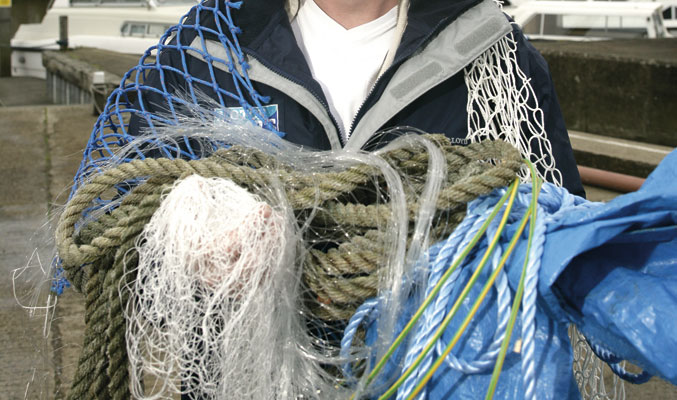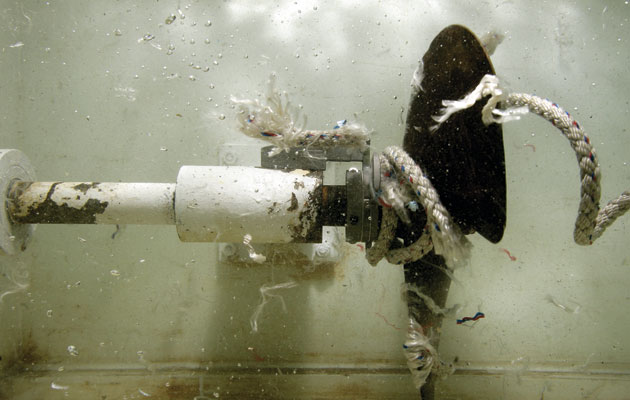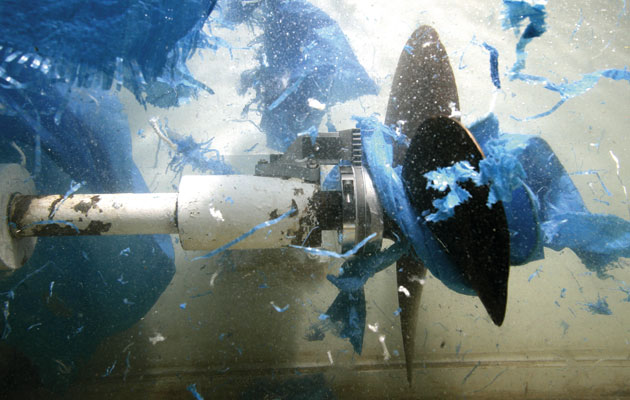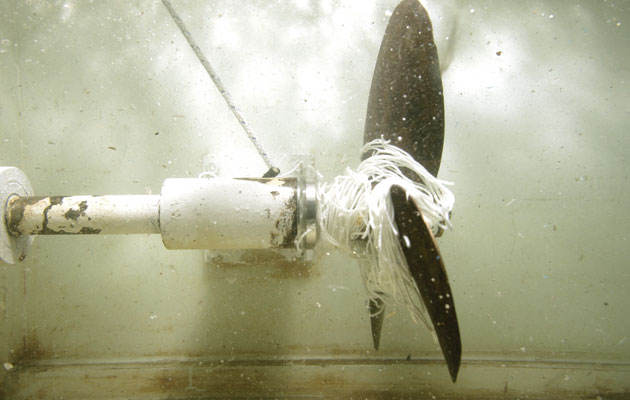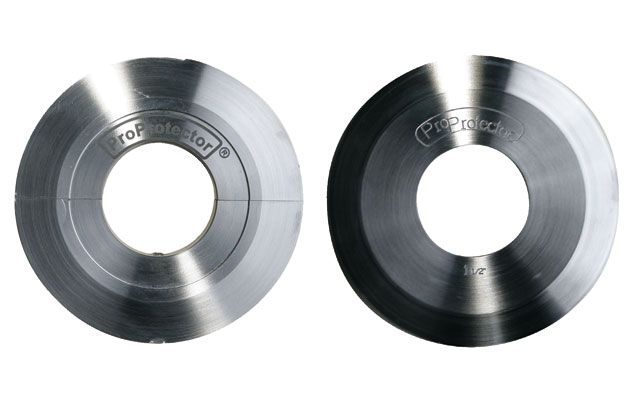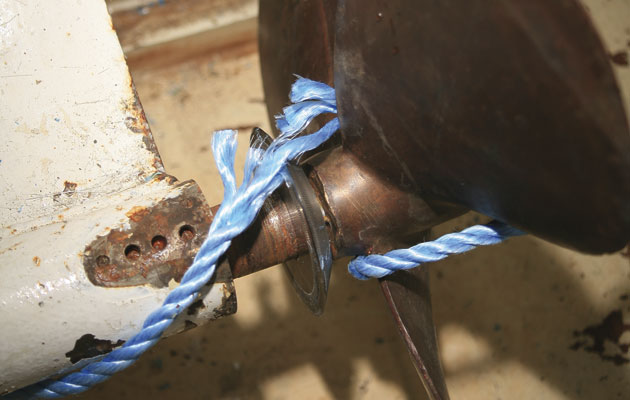At best, a rope around the propeller is inconvenient. At worst, it’s deadly. Emrhys Barrell tests seven rope cutters to find out if they really can keep your prop turning
Propeller rope cutter test
‘Cast off the bow line,’ I called. I waited for the line to sink and engaged forward gear to leave our marina berth in the Mediterranean. I should have waited longer. Suddenly, the engine died as the fixed mooring line was now firmly wrapped around the three-blade propeller of our Gib’Sea 32. Back in our berth, I cut an 8ft length from the end of a hosepipe, attached one end to a stanchion, put the other in my mouth and stepped off the stern to investigate [THIS IS NOT RECOMMENDED].
The line was soon freed and we left with nothing more serious than dented pride and a slightly shorter hosepipe, but a boat rope wrapped around the prop can often have more serious consequences. On a lee shore in a gale, or in foggy shipping lanes, it could easily end in disaster. Whether it’s a stray sheet tail or an abandoned fishing net, once you lose propulsion, you lose a lot of options.
Fitting a rope cutter is a good way of keeping your options open, but how effective are they? We located a test tank and put seven different cutters to the test, to see how good they are at slicing through ropes, fishing nets, wire and plastic – and still keep your prop turning. This is the most comprehensive and detailed study of rope cutters published in a UK sailing magazine.
How rope cutters work
There are at least eight different makes of cutter on the UK market. Three are scissors-type cutters, four use discs and one is a shaver.
Scissors
The scissors-type was the first on the market. It comprises a rotating cutter clamped to the shaft, with two or more blades, plus a fixed cutter bolted to the P-bracket. As the prop rotates, obstructions are drawn down into the scissor blades and cut or chopped up.
The advantage is a positive cutting action, which also shreds weed and netting. There are various drawbacks: it’s a complex installation and you may need to fit a spacer in the gearbox coupling. Every two years or so, you will have to replace the thin plastic bearings, on which the fixed cutter spins on the shaft. Scissor cutters cause more drag than some other types and are the most expensive to buy.
Because of the loads on the fixed block of the scissor-types, they can usually only be fitted to metal P-brackets, stern tubes or hulls. GRP is not strong enough to stop the tapped machine-screws pulling out, though in some cases a plate can be made up to take the block, which is then glassed or bolted to the hull or tube. A scissor cutter is the only option for saildrives.
Disc
This type of cutter is a thin stainless steel disc with a sharpened edge. The disc can be split and clamped round the shaft, or solid, in which case the prop has to be removed and the disc slid up the shaft. In both cases the cutter is held in place with a grub screw. As the shaft spins, any rope or debris that is drawn down to the disc is gradually cut through as it passes over the knife-edge.
The advantages are simple installation and low cost, plus minimal drag underway. Disadvantages include the lack of a positive cutting action – discs can struggle to cut through weed and plastic sheeting. Disc types can be fitted to any shaft-drive boat. For a long-keel yacht with a keel-hung rudder, you may have to widen the prop aperture on the leading edge of the rudder.
Shaver
The shaver is a new development comprising fixed blades mounted on a block attached to the P-bracket or stern tube. GRP stern tubes may need some strengthening, depending on build quality. A plastic spool or cylinder is slid over the shaft and attached to the front boss of the prop, running under the cutter blades. As rope or debris is encountered, it is forced into the gap between the blades and the prop. As the blades spin, the rope is gradually shaved through.
Advantages include reduced load on the structure and transmission during cutting, plus minimal loss of boat speed. The disadvantage is complex installation and the need for accurate fitting in a machine shop. Pricewise, shavers are midway between discs and scissors, although you would have to add in the cost of machining the prop and sometimes the P-bracket, too.
How we tested the rope cutters
We explained to all eight manufacturers how our tests would be conducted and invited suppliers to send us samples and attend the test. Plastimo couldn’t provide us with a unit, so we bought one. We were unable to test the Quickutter shaver – its maker declined to participate, citing concerns over the suitability of out test tank and rig for evaluating the performance of a shaver. We would be pleased to hear of any readers’ experiences with shaver-type cutters. It’s worth noting that the RNLI has fitted Quickutters to its entire fleet of Tamar-class lifeboats.
We fitted each of the cutters in turn to the test rig’s P-bracket and shaft to see how easy this was to carry out. In theory, anyone with reasonable DIY skills can fit a cutter to their boat. In practice, you need to be confident of your abilities, especially with the scissor-action units. When it is working in anger, a scissor cutter exerts enormous loads, especially to the fixed structure it is attached to, and it is no use if it breaks free. Disc cutters put less load on the structure, but even these need to be competently fitted. If you are in any doubt, get a boatyard to fit it for you.
You could dry your boat out against an old quay wall and work with one eye on the encroaching flood-tide, but for most owners the sensible option is to haul out for the fitting. Bear in mind that a quick lift – with the boat not leaving the slings, and the yard doing the job for you – will usually cost no more than having her lifted into a cradle, ready for you to do the honours.
For the scissors-type, you will have to drill and tap the P-bracket accurately. You also need to be sure that you have the correct clearance between the P-bracket or stern bearing and the prop. This distance is critical for all cutters, but especially for the scissor-action models. Many shafts will not have enough free length exposed, in which case you will have to fit a spacer between the gearbox and the coupling to move the shaft back by the required amount. Cutter manufacturers can usually supply you with the right spacer to suit most common gearboxes.
Cutters must be spaced 6-10mm back from the P-bracket or stern tube to take up any movement as the engine goes into ahead, and to allow a flow of water through the cutless bearing. All cutters must be fitted to the parallel section of the shaft, not the taper, or they will slip. Scissor types also need to be lined up correctly, relative to the propeller blades, to reduce interference with water flow into the prop. All manufacturers recommend you use a threadlock liquid on the screws to prevent them undoing.
The test tank
The tank was 1.2m long, 0.6m wide and 0.9m deep. In this was fixed a P-bracket
with a cutless bearing carrying a 3.81cm (1½in) mild steel shaft with a tapered end, and a 40cm by 30cm (16in by 12in) fixed three-blade bronze prop driven by a 2.2kW electric motor.
The test materials
The most common material encountered on passages is floating rope, either long lengths or bundles. Also common is netting of all sizes and thicknesses, and plastic sheeting, fertiliser bags or tarpaulin. Finally, you could also hit a lobster pot line.
To best replicate these materials, we took the following: three-strand polypropylene rope – 6mm, 12mm and 25mm diameter; three-strand and braided polyester – 15mm and 25mm; and three-strand 15mm nylon rope.
We also tried a wide variety of netting, from the finest monofilament, through 3mm nylon and up to 4mm polypropylene. These nets, we are assured by a UK fishing industry supplier, are what you are most likely to encounter around our coasts. The net was cut into 1m x 2m rectangles and fed into the prop.
We then took heavy-duty polytarp sheeting, also cut into 1m x 2m rectangles. This was followed by 10mm2 copper cable, and finally 1.5mm-diameter galvanised steel wire, both single strand and cable.
The Test
We started the engine in ahead, and got it running up to speed. Initially, we fed the rope into the scissor cutters and let them draw it in and cut it up. However, the disc cutters didn’t pull the rope in – there was no load on it, so they wouldn’t cut it. In a real-life situation, you would be encountering long lengths or bundles of rope, which would provide tension at the end, or the rope would get caught round your stern gear, which would also create resistance and tension.
To simulate this effect, we fed the rope from ahead of the P-bracket, with one turn taken round it, and kept a gentle tension on the end. This drew the rope down onto the blades.
If the cutters chopped the rope, we classed this as a ‘pass’. Sometimes the ropes would stall the motor, so we reversed its direction, which again you would do in real life. It should be noted that we were only using a 3hp motor. In reality, greater horsepower would make the cutting action more effective. The same techniques were applied to the netting and tarp but the wire was fed into the spinning cutter from ahead.
Spurs 4*
Design
This was the first successful cutter, developed in 1982 in the USA. A scissors-type, it comprises two spinning blades and one fixed. The blades are claw-shaped, so rope can be trapped between them as they spin, and can’t be thrown out. The blades are made from hardened 17-4PH grade stainless steel. Spurs claims this makes it sharper for longer and can deal with harder materials better. This grade of stainless is more prone to corrosion, so a small anode is fitted as standard. Fitting is straightforward, with a 16-page manual.
On test
The Spurs chopped through every type of rope instantly and the finer netting. The toughest net required reversing the engine but this is what you would do in practice. The tarpaulin was also dealt with quickly, with one reverse chewing it up completely. The copper wire was snipped in one pass, as was the steel rod. The flexible wire was cut once but the second time it jammed between the blades. In fairness, the manufacturer doesn’t claim this unit will cut wire.
Sizes: From ¾in to 6½in
Drive: Shaft only
Stripper 4*
Design
The only cutter that fits a saildrive, Ambassador Marine’s Stripper arrived on the market shortly after Spurs. This manufacturer took an alternative design for its cutters, with serrated edges claiming to hold the rope in the jaws while it is being cut. Otherwise it uses the same principle of a fixed block, machine-screwed to the P-bracket with fixed and cutting blades on the shaft. It is made of 316-grade stainless steel, unhardened. The Stripper is available in 2, 3 or 4-blade versions, depending on the number of blades on your prop. It also has the option of a venturi tube, clamped to the P-bracket, which is claimed to reduce cavitation over the prop, extending its life and reducing loss of performance underway. One other variation is jacking screws on the fixed block, which allow you to adjust its shape to different radius P-brackets.
On test
The Stripper cut all the rope quickly. On occasions free rope tended to be thrown out from the blades, but was drawn in and cut as soon as it wrapped round the shaft. Netting was quickly shredded, as was the polytarp, after one reverse. The copper wire was cut cleanly, as was the single strand steel but the steel wire tended to jam in the blades.
Sizes: From ¾in to 4in
Drive: Shaft or saildrive
Gator 4*
Design
This new unit on the market was developed by two boat owners tired of getting ropes caught round their props and breaking their existing cutters. They looked at the current designs and claim to have made improvements. The scissors-type Gator has three blades, which are serrated and dove-tailed in shape. This is claimed to snag ropes and prevent them from being thrown outwards. They have also strengthened key areas of the construction, beefing up the sections of the rings and their locking mechanism, and adding stiffeners to the back of the blades. It is made of unhardened, 316-grade stainless steel. The fixed block also has three jacking screws.
On test
The Gator instantly chopped the rope and shredded the netting and polytarp after a reverse, with no tendency to throw it outwards. The copper wire was chopped cleanly but the steel wire tended to jam the blades after one cut.
Sizes: From 1in to 3in
Drive: Shaft only
Plastimo 3*
Design
A solid disc cutter, so only available in slide-on versions. Made from unhardened 316 stainless steel, it has a serrated edge that claims to give a better cutting action. The disc section was thinner than its rivals and despite being supplied as suitable for a 1½in shaft, it seemed a loose fit. Fitting it was simple, though, once you had removed the prop.
On test
The Plastimo cutter cut the rope quickly and the netting eventually. It wasn’t clear whether the serrations were a benefit, giving more of a sawing action, or a drawback, tending to snag the materials, and stall the engine. The polytarp was cut once it was held down, the serrations doing a better job than the smooth discs, but at times it got snarled up round the prop. None of the wires were cut.
Sizes: From 22mm to 80mm
Drive: Shaft only
R&D 3*
Design
R&D Marine, a well-known supplier of stern gear, has recently developed a disc cutter. It features a tapered leading edge to the boss, which is machined to the outside diameter of the P-bracket. The benefit of this is that it shrouds the bracket, preventing rope from being drawn down into the gap between it and the cutter. Other features include holes through the disc, which claim to improve water flow to the prop. Made of 316 stainless, unhardened steel, it has heavier sections than its rivals.
On test
The R&D cutter cut the rope cleanly, and the netting after a couple of reverses with none of it being drawn down into the shaft. Again, the polytarp was cut as soon as tension was applied but it still hung round the blades on some occasions. Reversing removed it most times. None of the wires were cut.
Sizes: From 20-50mm
Drive: Shaft only
Prop Protector 3*
Design
This disc cutter has been on the market for over 10 years. Available in slide-on or clamp-on versions, it is easy to fit, backed up by a four-minute installation DVD. Just drill a dimple in the shaft, then clamp the two halves together, and tighten up the grub screw. It is made from unhardened 316 stainless steel. It had the sharpest edge of all the units, and came with a plastic ring to stop you from cutting yourself during fitting and a warning notice.
On test
The Prop Protector cut the rope cleanly, and all the netting. It didn’t shred the netting but cut through it, dividing it in two, and would prevent your boat being anchored by a long length. When the polytarp was left to drift into the prop, it tended to get caught on the blades and just swirled around, but as soon as a slight amount of tension was applied, it was cut through. However, it wasn’t shredded and sometimes remained on the blades, which would reduce thrust. In practice, a large sheet would possibly apply enough drag to make the cutter work. It couldn’t cut any of the wires, though. The netting and smaller diameter ropes could sometimes be drawn down into the gap between the cutter and the P-bracket but reversing tended to loosen this.
Sizes: From 1in to 4in
Drive: Shaft only
Shaft knife 3*
Design
Another disc cutter, this time from TW Norris, a supplier of propellers and stern gear. This cutter was found late in the day, so it missed the main photo session. However, we were still able to put it through the tests. This slide-on unit, made from unhardened stainless steel with a smooth edge, was simple to fit.
On test
The Shaft Knife performed similarly to the other smooth-edge discs, cutting the rope and netting, plus the tarpaulin when it was held down. None of the wires was cut.
Sizes: from ¾in to 2½in
Drive: Shaft only
Conclusion
Our test clearly shows that any rope cutter will bring a definite safety benefit. Watching them in action, it was amazing how quickly they all cut through most of the debris we threw at them.
Clearly the scissors-type had the edge in what they would handle, coping with rope, netting, polytarps and even copper or thin steel wire. The disc cutters sliced through rope and netting, and made a good shot at polytarp but this could sometimes defeat them. Disc cutters could potentially have the same problem with weed.
All three scissor cutters performed well, with each one having some advantages over the other styles on test. Of the discs, the clamp-on versions have a definite fitting edge, judging by the effort required to get the prop off our test rig. The R&D cutter benefits from its tapered leading edge, which shrouds the exposed shaft.
Obviously, price, ease of fitting and your boat’s hull type have a bearing on which you choose. The scissors-type is the most costly option. The disc-types are much cheaper to buy, and the clamp-on disc versions are the easiest to fit, taking just a few moments.
Enjoyed reading this?
A subscription to Yachting Monthly magazine costs around 40% less than the cover price.
Print and digital editions are available through Magazines Direct – where you can also find the latest deals.
YM is packed with information to help you get the most from your time on the water.
- Take your seamanship to the next level with tips, advice and skills from our experts
- Impartial in-depth reviews of the latest yachts and equipment
- Cruising guides to help you reach those dream destinations
Follow us on Facebook, Twitter and Instagram.






